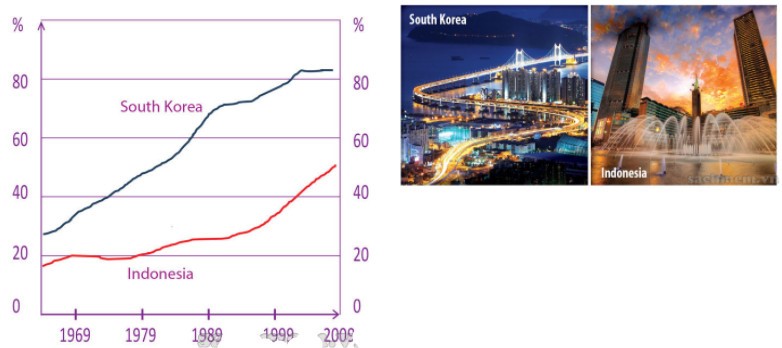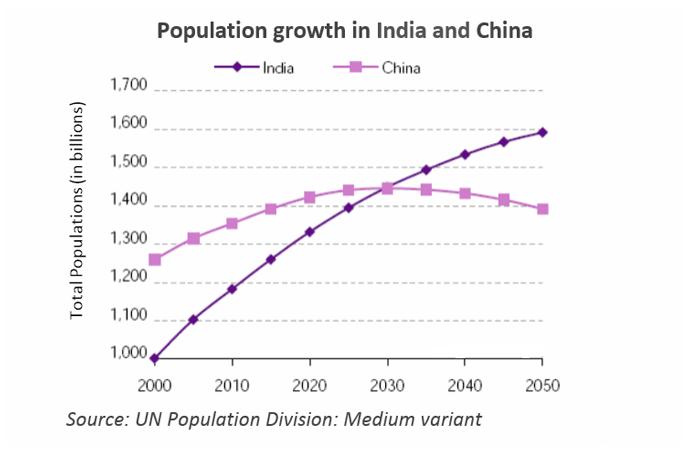Unit 2 lớp 12: Urbanisation-Writing
Bài học Unit 2 Tiếng Anh lớp 12 mới phần Writing hướng dẫn các em đọc biểu đồ và viết đoạn văn miêu tả theo biểu đồ đã cho về nội dung xoay quanh vấn đề Đô thị hoá.
Mục lục nội dung

Unit 2 lớp 12: Urbanisation-Writing
1. Task 1 Unit 2 lớp 12 Writing
Match the phrases in the box with the graphs (a-f) (Khớp cụm từ trong hộp với đồ thị (a-f))
Guide to answer
a. rise/increase steadily
b. fall/decrease sharply
c. stay the same/remain stable/level off
d. fluctuate
e. rise/increase sharply
f. fall/decrease steadily
Tạm dịch
a. rise/increase steadily: tăng dần
b. fall/decrease sharply: giảm mạnh
c. stay the same/remain stable/level off: giữ nguyên
d. fluctuate: biến động
e. rise/increase sharply: tăng mạnh
f. fall/decrease steadily: giảm dần
2. Task 2 Unit 2 lớp 12 Writing
Rewrite the sentences without changing their meaning (Viết lại câu mà không làm thay đổi nghĩa của chúng)
Examples
The number of young people working on farms has decreased sharply over the past years
⇒ There has been a sharp decrease in the number of young people working on farms
The number of urban inhabitants rose by 15% from 1990 to 1995
⇒ There was a rise of 15% in the number of urban inhabitants from 1990 to 1995
1. The migration of young people to big cities has risen dramatically
⇒ There ___________________________
2. Due to shortages of jobs, there has been a decrease in the population in rural areas in the last 10 years
⇒ Due to shortages of jobs, the population __________________
3. The urbanisation rate in Indonesia increased by over 30% from 1969 to 2009
⇒ There ________________________________________
4. There was a sharp rise in the rate of urbanisation in South Korea during the period between 1969 and 1989
⇒ The rate of urbanization __________________________
5. The urbanisation rate in this city decreased slightly during the economic crisis in 2008
⇒ There was ________________________________
Guide to answer
1. There has been a dramatic rise in the migration of young people to big cities
2. Due to shortages of jobs, the population in rural areas has decreased in the last 10 years
3. There was an increase of over 30% in the urbanisation rate in Indonesia from 1969 to 2009
4. The rate of urbanisation in South Korea rose sharply during the period between 1969 and 1989
5. There was a slight decrease in the urbanisation rate in this city during the economic crisis in 2008
Tạm dịch
Ví dụ:
Số người trẻ làm việc ở trang trại đã giảm mạnh trong những năm qua
⇒ Đã sự giảm mạnh về số lượng người trẻ làm việc ở trang trại trong những năm qua
Số người sống ở đô thị đã tăng 15% từ năm 1990 đến 1995
⇒ Có sự tăng 15% về số người sống ở đô thị từ năm 1990 đến 1995
1. Việc di cư của người trẻ đến các thành phố lớn tăng lên đáng kể
⇒ Đã có sự tăng mạnh mẽ trong việc di chuyển của người trẻ đến các thành phố lớn
2. Do thiếu việc làm, có sự giảm dân số ở nông thôn trong 10 năm qua
⇒ Do thiếu việc làm, dân số ở nông thôn đã giảm trong 10 năm qua
3. Tỉ lệ đô thị hóa ở Indoneisa đã tăng hơn 30% từ năm 1969 đến năm 1989
⇒ Từ năm 1969 đến năm 2009, đã tăng hơn 30% trong tỷ lệ đô thị hóa ở Indonesia
4. Có sự tăng tỷ lệ đô thị hóa ở Hàn Quốc trong giai đoạn từ 1969 đến 1989
⇒ Tỉ lệ đô thị hóa ở Hàn Quốc tăng mạnh trong khoảng thời gian từ 1969 đến 1989
5. Tỷ lệ đô thị hóa trong thành phố này giảm nhẹ trong khủng hoảng kinh tế năm 2008
⇒ Trong giai đoạn khủng hoảng kinh tế năm 2008, tỷ lệ đô thị hóa ở thành phố này đã giảm nhẹ
3. Task 3 Unit 2 lớp 12 Writing
The line graph below shows the urbanisation rate in South Korea and Indonesia. Write a description (of about 150 words) of the trends in the graph (Đường đồ thị dưới đây cho thấy tỷ lệ đô thị hóa ở Hàn Quốc và Indonesia. Viết mô tả (khoảng 150 từ) về các xu hướng của đồ thị)
Guide to answer
The line graph shows the rate of urbanisation in two countries, namely Indonesia and South Korea, from the mid-1960s to 2009
In the mid-1960s, the rate of urbanisation in Indonesia was about 17%, followed by a slight increase of 3% in 1969. Then the rate remained stable at around 20% for a ten-year period from 1969 to 1979. In the next fifteen years, there was a steady rise in the rate of urbanisation in this country. From 1995 to 2009, Indonesia's urbanisation rate increased sharply, reaching over 50%
South Korea's urbanisation rate was about 30% in 1969, roughly 10% higher than that of Indonesia. The rate went up sharply throughout the next thirty-year period to about 82% in 2005, and then levelled off towards 2009
In conclusion, it is clear that while both countries experienced a growth in their urbanisation rate, in South Korea it almost doubled by the end of the period
Tạm dịch
Đường đồ thị cho thấy tỷ lệ đô thị hóa của hai nước, cụ thể là Indonesia và Hàn Quốc, từ giữa những năm 1960 đến 2009
Vào giữa những năm 1960, tỷ lệ đô thị hóa ở Indonesia là khoảng 17%, tiếp theo là tăng nhẹ 3% vào năm 1969. Sau đó, tỷ vẫn ổn định ở mức khoảng 20% trong thời gian mười năm từ năm 1969 đến năm 1979. Trong mười lăm năm sau, đã có một sự gia tăng ổn định trong tỷ lệ đô thị hóa ở đất nước này. Từ năm 1995 đến năm 2009, tỷ lệ đô thị hóa của Indonesia tăng mạnh, đạt trên 50%
Tỷ lệ đô thị hóa của Hàn Quốc là khoảng 30% trong năm 1969, cao hơn so với Indonesia khoảng 10%. Tỷ lệ tăng mạnh trong suốt thời gian ba mươi năm tới khoảng 82% vào năm 2005, và sau đó chững lại khi hướng tới năm 2009
Kết luận, rõ ràng rằng trong khi cả 2 nước trải qua một sự tăng trưởng đô thị hóa ở tốc độ nhất định, ở Hàn Quốc gần như tăng gấp đôi vào cuối thời kỳ
4. Practice
The graph below shows population figures for India and China since the year 2000 and predicted population growth up until 2050. Write a description (of about 150 words) of the trends in the graph (Biểu đồ bên dưới thể hiện biến động dân số ở Ấn Độ và Trung Quốc kể từ năm 2000 và dự đoán về sự gia tăng dân số tới năm 2050. Viết một đoạn mô tả (khoảng 150 từ) thể hiện xu hướng của biểu đồ trên)
5. Conclusion
Kết thúc bài học Unit 2 Tiếng Anh Lớp 12 mới – Writing, các em học sinh cần lưu ý dàn bài nhận xét biểu đồ đường được tóm tắt như sau
- Introduction sentences: The chart shows/ illustrates/ indicates
- Overview: It is clear from the chart/ According to the chart/ It can be seen that
- Details: S + V + Adv + …/ There was + a/an + Adj + N + in …
Tham khảo thêm
- docx Unit 2 lớp 12: Urbanisation-Getting Started
- docx Unit 2 lớp 12: Urbanisation-Language
- docx Unit 2 lớp 12: Urbanisation-Reading
- docx Unit 2 lớp 12: Urbanisation-Speaking
- docx Unit 2 lớp 12: Urbanisation-Listening
- docx Unit 2 lớp 12: Urbanisation-Communication and Culture
- docx Unit 2 lớp 12: Urbanisation-Looking Back
- docx Unit 2 lớp 12: Urbanisation-Project







